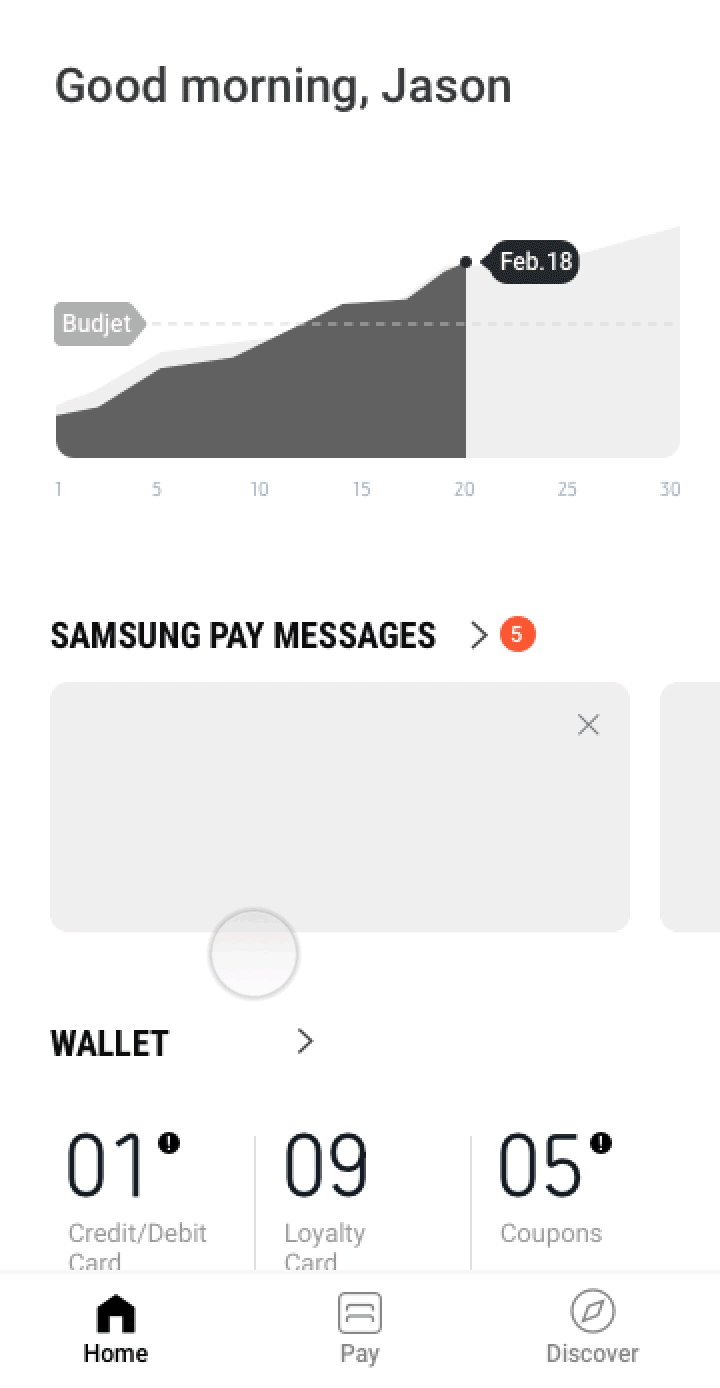Samsung Pay
Samsung Research America
Samsung Pay
Jan 2017 - present
_
What is Samsung Pay?
Samsung pay is a payment app used for both in-store and online payments. It allows users to securely digitize and store their payment cards on a mobile device, eliminating the need for the physical cards. Samsung Pay is the most widely accepted digital wallet — about 80 percent of US merchants are available — with approximately 35M registered users just in US. The product is present in 25 countries worldwide.
_
My role: Senior UX Designer
Conducted benchmark studies, user testing sessions, users interviews, influenced the new branding direction, produced wireframes, flows, UI and GUI guides. I conducted initial evaluation of the in-app experience and ideated on effective ways of surfacing content on the Samsung Pay home page and for the overall app redesign.
Worked on a daily basis with the creative team, engineers, researchers, PMs and high level management in US and Korea.
Took part of the hiring process for a UX Designer, UX Researcher and Motion Designer.
Once the team expanded, we conducted many collaborative group design workshops to define Samsung Pay new experience, architecture and functionalities. I used my initial findings in both individual and group concepting sessions to inform the evolution of sketches, wireframes, and idea clustering sessions.
_
The initial phase:
Deconstructing the experience
The business and project management teams looked to our team to evaluate the Samsung Pay experience and figure out how to increase user engagement with Samsung Pay. There were many newly proposed features from the product management team to boost user engagement, but all of them took the approach of the building on top of what already exists rather than looking at deeper structural issues that might hinder engagement.
I worked with a co-designer and the design lead to deconstruct the status-quo. There was no design researcher, and so it was up to the three of us to go out and pinpoint the issues. There was limited budget and very limited time to make the next release, so our initial hypothesis was shaped by observations from internal members of the Samsung Pay team, as our own personally mapped out experiences.
_
The Challenges:
Market adoption and content surfacing
The US team inherited the Korean app in January 2017 and the main challenge was to transform a Korean product into a product first for the US market and pave the new experience, architecture and GUI guides for the rest of the 24 countries in the world.
There was so much content and functionality built into Samsung Pay, but users weren't aware of most of it. During my internal studies, the first thing to come to mind was adding/changing card information, and that was where exploration stopped. Most of Samsung Pay's content was burried 5 layers down, well out of sight and mind.
Our problem statement: How might Samsung help users save time and save money, while helping them make useful discoveries along the way?
_
The Approach:
More than just a payment
What if Samsung Pay were a shopping assistant?
What if it guided your through your shopping experience based on deals from the Samsung Pay app?
Maybe it could act as a quick reference. Scan the item of interest and find a discount relevant to the item.
What if you scanned the item of interest and Samsung Pay found you a deal from the app as well as price comparisons from retails in the area?
What if you fed Samsung your calender and could then offer you precisely timed deals or gift cards for when that friend’s birthday is coming up?
These are just a few of the many ideas that came from examining the shopping experience; I started the experience by thinking big. By looking at each moment of the experience, from the factors that are taken into consideration before arriving at the store, the moment one hits the ‘Buy’ button from their laptop or mobile device, or arrives in parking lot at the nearby mall. My manager encouraged me to look past the low-hanging fruit and to look under every stone for areas of opportunity.
I also took note of the types of shoppers.
The shopper in the explorer mentality enjoys going to the physical store and exploring things with their senses. This type of shopper compares and contrasts, and may enjoy making new discoveries along the way.
Other shoppers take the more targeted mentality; they’ve done the research even before entering the store. They have a list and they know exactly what they want. Their goal is to save time and save money.
_
The Payges experience
From our initial design research, many ideation sessions, multiple rounds of product management input, and dev team review, we created Payges.
Payges is a lifestyle app that surfaces content relevant to the user's likes, dislikes, and context. It is about building out a UI with efficient, reusable components and bringing the right information to the user at the right time.
_
Next design steps
The first release was only the beginning. Due to time constraints and technical limitations, we had to scale down to the minimum desirable product while still keeping the dream experience in mind. We continue to refine the Samsung Pay experience through focused user tests, internal feedback, and team collaboration.






